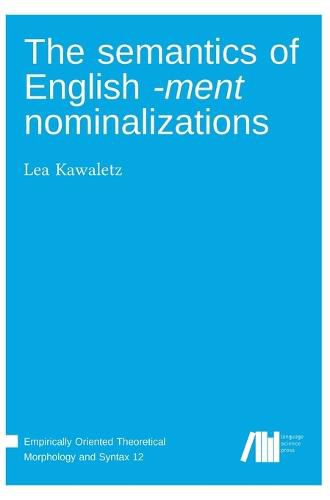Readings Newsletter
Become a Readings Member to make your shopping experience even easier.
Sign in or sign up for free!
You’re not far away from qualifying for FREE standard shipping within Australia
You’ve qualified for FREE standard shipping within Australia
The cart is loading…






It is well-known that derivational affixes can be highly polysemous, producing a range of different, often related, meanings. For example, English deverbal nouns with the suffix -er can denote instruments (opener), agents (writer), locations (diner), or patients (loaner). It is commonly assumed that this polysemy arises through a compositional process in which the affix interacts with the semantics of the base. Yet, despite intensive research in recent years, a workable model for this interaction is still under debate. In order to study and model the semantic contributions of the base and of the affix, a framework is needed in which meanings can be composed and decomposed.In this book, I formalize the semantic input and output of derivation by means of frames, that is, recursive attribute-value structures that serve to model mental representations of concepts. In my approach, the input frame offers an array of semantic elements from which an affix may select to construct the derivative's meaning. The relationship between base and derivative is made explicit by integrating their respective frame-semantic representations into lexical rules and inheritance hierarchies. I apply this approach to a qualitative corpus study of the productive relationship between the English nominalizing suffix -ment and a semantically delimited set of verbal bases. My data set consists of 40 neologisms with base verbs from two semantic classes, namely change-of-state verbs and verbs of psychological state. I analyze 369 attestations which were elicited from various corpora with a purposeful sampling approach, and which were hand-coded using common semantic categories such as event, state, patient and stimulus. My results show that -ment can target a systematically restricted set of elements in the frame of a given base verb. It thereby produces a range of possible readings in each derivative, which becomes ultimately interpretable only within a specific context. The derivational process is
$9.00 standard shipping within Australia
FREE standard shipping within Australia for orders over $100.00
Express & International shipping calculated at checkout
It is well-known that derivational affixes can be highly polysemous, producing a range of different, often related, meanings. For example, English deverbal nouns with the suffix -er can denote instruments (opener), agents (writer), locations (diner), or patients (loaner). It is commonly assumed that this polysemy arises through a compositional process in which the affix interacts with the semantics of the base. Yet, despite intensive research in recent years, a workable model for this interaction is still under debate. In order to study and model the semantic contributions of the base and of the affix, a framework is needed in which meanings can be composed and decomposed.In this book, I formalize the semantic input and output of derivation by means of frames, that is, recursive attribute-value structures that serve to model mental representations of concepts. In my approach, the input frame offers an array of semantic elements from which an affix may select to construct the derivative's meaning. The relationship between base and derivative is made explicit by integrating their respective frame-semantic representations into lexical rules and inheritance hierarchies. I apply this approach to a qualitative corpus study of the productive relationship between the English nominalizing suffix -ment and a semantically delimited set of verbal bases. My data set consists of 40 neologisms with base verbs from two semantic classes, namely change-of-state verbs and verbs of psychological state. I analyze 369 attestations which were elicited from various corpora with a purposeful sampling approach, and which were hand-coded using common semantic categories such as event, state, patient and stimulus. My results show that -ment can target a systematically restricted set of elements in the frame of a given base verb. It thereby produces a range of possible readings in each derivative, which becomes ultimately interpretable only within a specific context. The derivational process is